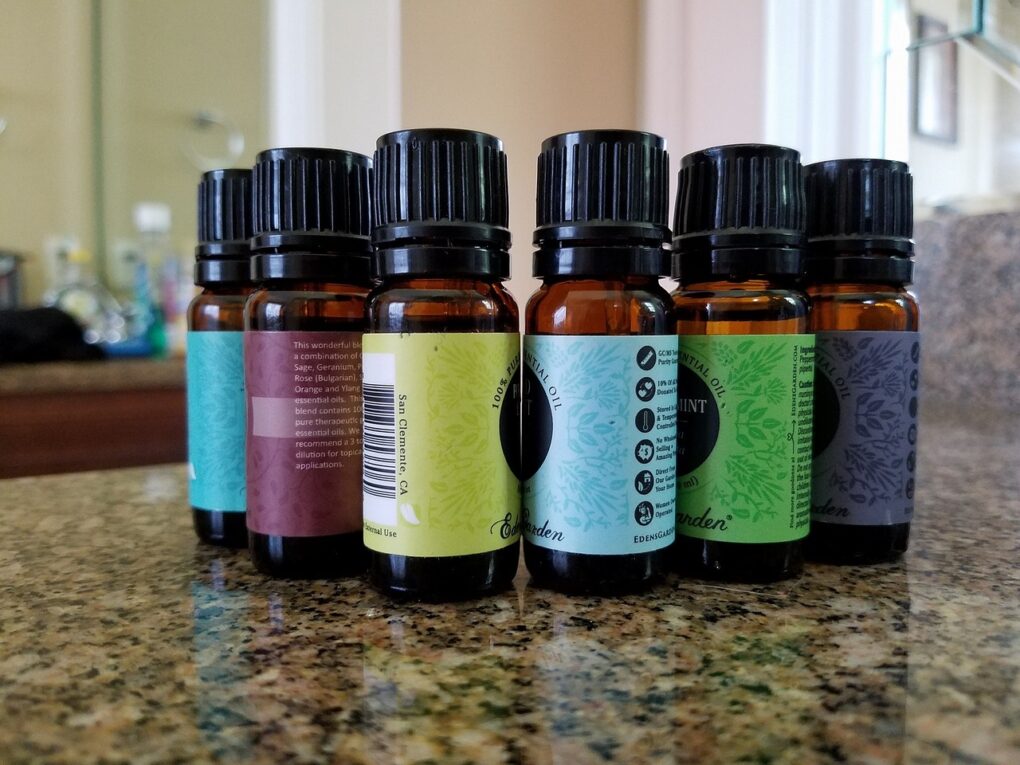Aromatherapy involves the use of essential oils extracted from plants to promote health and well-being. These essential oils capture the plant’s scent and flavor, or “essence.” Each essential oil has unique chemical compounds that determine its characteristic aroma and therapeutic properties.
History of Aromatherapy
The roots of aromatherapy can be traced back to Ancient civilizations, including the Egyptians, Greeks and Chinese, who used aromatic plants in religious rituals as well as for cosmetics and medicinal purposes. The term “aromatherapy” was first coined by French chemist René-Maurice Gattefossé in the early 20th century, who discovered the healing properties of lavender oil.
Health Benefits of Aromatherapy
Aromatherapy offers a natural and holistic approach to enhancing health and well-being. By incorporating essential oils into your daily routine, you can experience their therapeutic benefits, from stress relief and improved sleep to pain management and immune support.
Below are some of the ways that aromatherapy can help with well-being, as well as examples of oils that can be used in each category:
Aromatherapy for Stress Relief and Relaxation
Aromatherapy is widely known for its ability to reduce stress and promote relaxation.
Popular Aromatherapy Oils for Relaxation:
Lavender: Known for its calming properties, lavender oil can help reduce anxiety and improve sleep quality.
Chamomile: Chamomile oil is another popular choice for relaxation and stress relief.
Aromatherapy for Pain Management
Essential oils can help alleviate various types of pain, including headaches, muscle aches, and joint pain.
Popular Aromatherapy Oils for Pain Management:
Peppermint: Peppermint oil has analgesic properties that can relieve headaches and muscle pain.
Eucalyptus: Eucalyptus oil is effective for reducing inflammation and soothing joint pain.
Aromatherapy for Improved Sleep
Certain essential oils can enhance the quality of sleep by promoting relaxation and reducing insomnia.
Popular Aromatherapy Oils for Improved Sleep:
Lavender: Lavender oil is commonly used to improve sleep quality and reduce insomnia.
Bergamot: Bergamot oil has calming effects that can help with sleep disorders.
Aromatherapy to Boost the Immune System
Aromatherapy can support the immune system and help ward off illnesses.
Popular Aromatherapy Oils to Boost the Immune System:
Tea Tree: Tea tree oil has antimicrobial properties that can boost the immune system.
Lemon: Lemon oil is known for its immune-boosting and antibacterial properties.
Aromatherapy Oils to Enhance Mood and Cognitive Function
Essential oils can positively affect mood and cognitive function.
Popular Aromatherapy Oils to Enhange Mood and Cognitive Function:
Rosemary: Rosemary oil can improve concentration and memory.
Citrus Oils: Oils like orange and lemon can elevate mood and reduce feelings of depression.
How to Use Aromatherapy Oils
Below we will cover the main ways that essential oils are used for aromatherapy:
Inhalation
Inhalation is one of the most common methods of using essential oils. Inhalation can be achieved in the following ways:
Diffusers: Add a few drops of essential oil to a diffuser to disperse the aroma throughout the room.
Steam Inhalation: Add essential oils to a bowl of hot water, cover your head with a towel, and inhale the steam.
Addition to Clothing or Bedding: A few drops of essential oil can be added to clothing or bedding, so that the neat oil can be inhaled without direct contact with the skin. This is a popular choice for lavender at bedtime.
Topical Application
Essential oils can be applied directly to the skin, but they should always be diluted with a carrier oil to prevent irritation.
Massage: Combine essential oils with a carrier oil like coconut or jojoba oil and use it for a relaxing massage.
Bath: Add a few drops of essential oil to a warm bath for a soothing experience.
Internal Use – with Caution!
Some essential oils can be ingested, but this should only be done under the guidance of a qualified professional.
Teas: Certain essential oils can be added to herbal teas for therapeutic effects.
Capsules: Essential oils can be taken in capsule form for internal benefits.
Popular Essential Oils and Their Uses – Top, Middle and Base Notes
In aromatherapy, essential oils are often described in terms of their “notes” – top, middle and base. These categories help in understanding how different oils can be blended for therapeutic effects and how their scents unfold over time. By understanding these notes, aromatherapists can create well-balanced and effective essential oil blends tailored to specific needs and preferences.
Essential Oils – Top Notes
Examples of Top Notes Essential Oils:
Basil, Bergamot, Cajuput, Clary Sage, Eucalyptus, Lemon, Tea Tree
Characteristics: Light, fresh, and uplifting.
Evaporation Rate: Fast; these scents are usually the first to be perceived and fade quickly.
Examples: Citrus oils (like lemon, lime, and bergamot), eucalyptus, peppermint.
Role: They provide the initial impression of a blend and are often used to refresh and invigorate.
Essential Oils – Middle Notes
Examples of Middle Notes Essential Oils:
Camomile, Cardamon, Fennel, Geranium, Lavender, Marjoram, Melissa, Rosemary
Characteristics: Warm, soft, and balancing.
Evaporation Rate: Medium; they emerge once the top notes dissipate and can last for a few hours.
Examples: Lavender, chamomile, rosemary, tea tree.
Role: They form the heart of the blend, providing balance and harmony to the overall scent profile.
Essential Oils – Base Notes
Examples of Base Notes Essential Oils:
Benzoin, Black pepper, Cedarwood, Cypress, Frankincense, Jasmine, Myrrh, Neroli, Patchouli, Rose, Sandalwood, Ylang Ylang
Characteristics: Deep, rich, and grounding.
Evaporation Rate: Slow; these scents develop later and linger the longest.
Examples: Sandalwood, patchouli, cedarwood, frankincense.
Role: They add depth and longevity to the blend, anchoring the lighter notes and giving the blend staying power.
Shopping
| Visit the new SHOPPING page for a wide selection of amazing products! |
Below is a list of the most popular essential oils and their uses:
Basil
Description: Sweet, spicy scent known for its medicinal properties.
Uses: Alleviates headaches, improves digestion, and relieves stress.
Benzoin
Description: Warm, vanilla-like aroma with calming effects.
Uses: Soothes respiratory issues, relieves stress, and promotes skin healing.
Bergamot
Description: Citrusy and floral scent with calming effects.
Uses: Mood enhancement, stress relief, and improved sleep.
Black Pepper
Description: Warm, spicy scent with stimulating properties.
Uses: Pain relief, digestion aid, and respiratory support.
Chamomile
Description: Sweet, fruity scent with soothing properties.
Uses: Relaxation, stress relief, and skin care.
Camphor
Description: Strong, penetrating aroma with cooling properties.
Uses: Relieves pain, reduces inflammation, and soothes respiratory issues.
Cedarwood
Description: Woody, grounding scent with calming effects.
Uses: Stress relief, improved sleep, and skin care.
Clary Sage
Description: Herbaceous, slightly floral scent with calming effects.
Uses: Hormonal balance, stress relief, and improved sleep.
Cypress
Description: Fresh, clean scent with energizing properties.
Uses: Improves circulation, reduces stress, and supports respiratory health.
Eucalyptus
Description: Strong, fresh, and camphoraceous scent.
Uses: Respiratory support, pain relief, and antimicrobial effects.
Fennel (not bitter fennel)
Description: Sweet, anise-like aroma with digestive benefits.
Uses: Improves digestion, balances hormones, and reduces inflammation.
Frankincense
Description: Earthy, woody aroma with a hint of spice.
Uses: Immune support, stress relief, and skin care.
Geranium
Description: Sweet, floral scent with balancing properties.
Uses: Skin care, stress relief, and hormonal balance.
Jasmine
Description: Rich, floral aroma known for its aphrodisiac properties.
Uses: Mood enhancement, stress relief, and skin care.
Juniper
Description: Fresh, woody scent with detoxifying properties.
Uses: Detoxification, stress relief, and skin care.
Lavender
Description: Known for its calming and relaxing properties.
Uses: Stress relief, improved sleep, pain relief, and skin care.
Marjoram
Description: Sweet, woody scent with calming effects.
Uses: Muscle pain relief, improved sleep, and stress reduction.
Melissa
Description: Fresh, lemony scent with calming properties.
Uses: Reduces stress, improves sleep, and supports digestion.
Myrrh
Description: Warm, earthy aroma with grounding properties.
Uses: Skin healing, immune support, and stress relief.
Neroli (Orange Blossom)
Description: Sweet, floral scent with calming effects.
Uses: Mood enhancement, stress relief, and skin care.
Patchouli
Description: Rich, musky-sweet scent with grounding properties.
Uses: Skin care, stress relief, and hormonal balance.
Peppermint
Description: Refreshing and invigorating, with a cool, minty scent.
Uses: Pain relief, digestive aid, and respiratory support.
Rose
Description: Rich, floral aroma known for its uplifting properties.
Uses: Mood enhancement, skin care, and hormonal balance.
Rosemary
Description: Herbaceous scent known for stimulating cognitive function.
Uses: Cognitive enhancement, pain relief, and hair care.
Sandalwood
Description: Warm, woody scent with calming effects.
Uses: Stress relief, improved sleep, and skin care.
Ylang-Ylang
Description: Sweet, floral scent with calming and uplifting properties.
Uses: Mood enhancement, stress relief, and skin care.
Aromatherapy Safety and Precautions
While aromatherapy is generally safe, it is important to use essential oils with care. As with any therapy, it’s important to use essential oils safely and consult with professionals when needed.
Dilution: Always dilute essential oils with a carrier oil before applying them to the skin to prevent irritation.
Patch Test: Perform a patch test to check for allergic reactions before using a new essential oil.
Consultation: Consult with a healthcare provider before using essential oils if you are pregnant, nursing or have underlying health conditions.
Quality: Use high-quality, pure essential oils to ensure safety and effectiveness.
Always take care when using essential oils and Read Our Disclaimer.
References
National Association for Holistic Aromatherapy (NAHA). (2021). Aromatherapy and Essential Oils.
Mayo Clinic. (2020). Aromatherapy: Do Essential Oils Really Work?
Gattefossé, R. (1937). Gattefossé’s Aromatherapy.
This article is intended for informational purposes and should not replace professional medical advice. Always consult with a healthcare provider for any health concerns.
Feel free to reach out for more personalized advice or share your experiences with aromatherapy in the comments below!



Leave a Reply